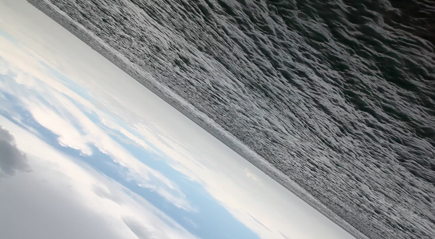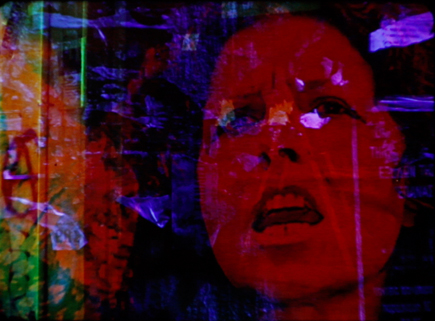Ben Russell’s Altered States
Ben Russell’s Altered States
“That’s the sun in my hands, man! Oh, it gives off an orange cloud of light that just flows right out over the sea! Wow!” – Peter Fonda as Paul Groves in The Trip (Roger Corman, 1967)
Cinema’s preoccupation with psychedelic drugs (be they acid or DMT or Mescaline or Ayahuasca or Peyote or _____) in the name of producing psychedelic effect is an admirable and time-honored project. It is an admirable project but it is one that is ultimately destined to fail, inasmuch as the project privileges effect over document, inasmuch as as it tries to make the glassy-eyed subject’s headtrip web of multiple dimensions into our very own movie theater trip. After all, the manipulation of time and space, aka That Radical Alteration of the Unconscious Act of Perception That We Are Always-Already Engaged In, is located at the blindingly reflective crystal heart of cinema. Cinema is its own realtime eye-and-ear melter, and to produce a film that merely emulates psychedelic experience (via the experience of psychedelics) is to impoverish it, to sell it the weakest dose possible.
After all, the transformation of three-dimensional space into two-dimensional space is one of the most profound perceptual illusions we experience on a regular basis, a monocular translation of binocular vision that, even when retrofitted with steroscopic lenses, is still fundamentally planar. We simply do not experience the world the way that a camera does; glass-lensed optics are so ecstatically other than the visions our own lenses allow. If we weren’t already so accustomed to misbelieving the depth inherent to flatness (a strategy that painters employed long before photo emulsion materialized), we would perpetually experience the perceptual strangeness of the 2-D image as if we were a 15-year old teenager tripping balls on LSD. Those over-saturated colors, that picture plane constituted entirely of tiny dots – every image a Seurat, every BBC Planet Earth episode an exercise in hyper-experience. We would get to see vision as a thing, we would re-learn to hear sounds as discrete events in time, sensations that had been molded and modeled and spread out to the 5.1 speakers around our heads. Only psychedelics offer a parallel experience – and only the Yanamano Indians know that cinema was developed well before the Lumiere Brothers ever proposed its existence.
The sort of bodily dissociation that cinema (when given a chance) can produce rhymes with the drippy long-limbed messiness that accompanies every other foray into drug-induced altered states. When the perceptual mode is foregrounded and the unconsciousness is consciously addressed, above all other things the attentive viewer finds herself to be startingly present. Not unlike the spectres projected on the screen before her, she is made material through projection, enters into consciousness through reflection. She finds herself in the light, literally – situated between projector and screen, her self suspended within and constituted by that ethereal body known as cinema. This decidedly psychedelic state of the cinema address, carries at its center a fundamental call for self-regard – to be tuned-in is to find yourself in a peripheral world that, for an indefinite cinema-instant, constitutes your everyday.
Central to this experience of self is the experience of self-in-time. The DMT user on a Businesssman’s Special knows precisely how elastic time is, how relative it is to perception. Her 8-minute trip is your 8-minute experimental film – which is to say, the moviegoer is no different. The unremitting forever of Warhol’s 8-hour Empire shares the same kind of temporal shock as an 8-hour acid trip – details become monuments when time is allowed to accumulate around them. In the most brilliant of moments, we lose track of the film, of ourselves, of time altogether (though we are never more aware of time than in this now). The legacy of Warhol and the relatively recent advent of slow cinema (see: Akerman, Alonso, Benning, Martin, Rivers) serves as testimony to this – time becomes markedly unfamiliar when recorded and re-presented, when we are asked to see the movement of the second hand as an object in of itself. In looking at time we move out of time, become subject to the expansion and contraction of duration that Maya Deren (among so many others) was so fond of. Indeed, cinema transfigures time in a fashion only known to us otherwise through dreams – where else do we experience the relativity of time firsthand?
The dreamer arrives at the appearance of wakefulness through the deepest of sleep, her brain producing time and space as a function of her own existence – and not vice versa, as occurs in her waking life. Only in those hypnagogic moments, when she is breathing the air of both worlds and has one eye open in each, can she begin to truly experience a simulation of the sort of psychedelia that cinema offers up. It is bodily but it is conscious, and its apparatus does not wear the veil of the dream-self or the drug-self that these others do. Cinema is clear and visible – there is a screen, a projector, a room, a handful of speakers. If we are lucky there is are constellations painted on the ceiling and a red curtain to cover the screen, there are other bodies around us. The trip, when it unspools, is objectively happening around us, in front of us – it is not only produced perceptually inside us, as is the case elsewhere. Here too, time is elastic, space is redefined, but in front of the silver screen the viewer is produced in such a way to be able to change her position, to alter the terms of her trip. She is acted upon, she cannot change the path of the projection, but she can still locate herself within it – can find herself without it as well, outside of the theater, in the car-honk and street-glow of St. Everywhere.
Given the numerous limitations placed upon this particular instrument, it is nothing short of miraculous when cinema is consumed in its full psychedelic glory – when that flat image splinters itself from a planar existence outwards and those spatialized sounds relativize time in a heretofore unimagined space – we are heralded anew. The gift of presence, of patience, that viewers give to cinema is in fact an allowance for the trip to begin. Cutting through the darkness, cinema expands and contracts, turning faces into whole geographies with a simple close-up, a quick edit. When we swallow the drug of cinema, when we allow the effect that is particular to its own formula to act upon us, our state is altered inextricably. Given this, and taking into account the radical fullness of the experience that cinema has to offer, we can see that to condemn cinema to the surface reflection of a drug user’s trip is to ask nothing at all. Drugs, like dreams, are best met on their own terms, seen through their own eyes. When cinema is viewed in like fashion, when it is given the freedom to be truly hallucinatory, when it is allowed to engage in the psychedelic function of Self, its own cinema-self is revealed to be truly phenomenal. The traits particular to cinema conspire together to occupy our sense of sensation, to change our relationship to time and space fundamentally – cinema is a trip, the sun in your hands.
Ben Russell
This article was originally published in “El espacio de las afecciones”, a reader edited by Eduardo Thomas to accompany the Injerto section of the Ambulante Film Festival in Mexico (2012).
Ben Russell has three films in this year’s BFI London Film Festival. Austerity Measures screens in OCCUPY THE CINEMA at ICA Cinema 1 on Thursday 11 October 2011, at 8pm. Ponce de León and River Rites are included in RITES OF PASSAGE at BFI Southbank on Saturday 20 October 2010, at 9pm.



